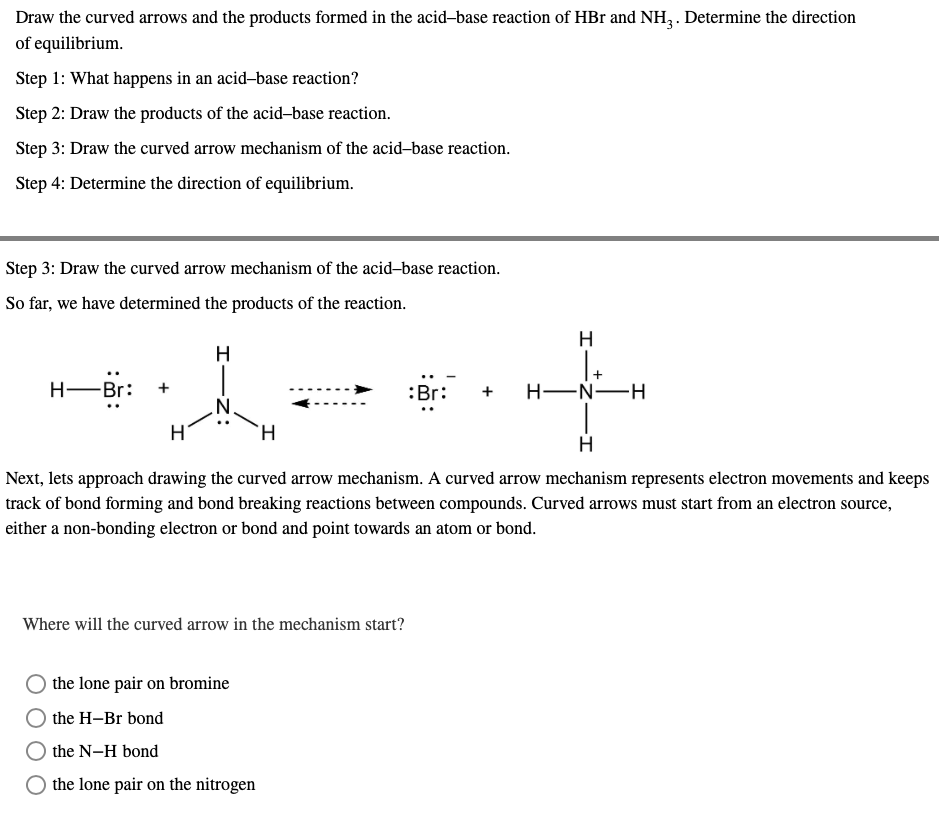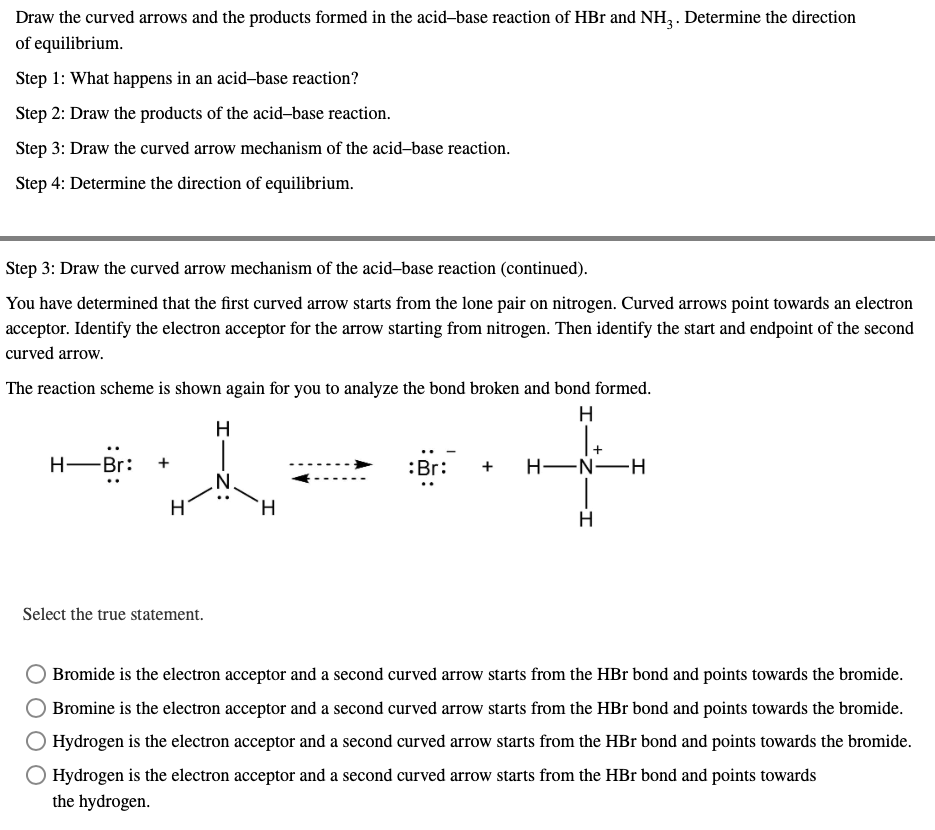Draw the curved arrows and the products formed in the acid-base reaction of HBr and NH3. Determine the direction of equilibrium. Step 1: What happens in an acid-base reaction? Step 2: Draw the products of the acid-base reaction. Step 3: Draw the curved arrow mechanism of the acid-base reaction. Step 4: Determine the direction of equilibrium. Step 3: Draw the curved arrow mechanism of the acid-base reaction. So far, we have determined the products of the reaction. H H H-Br: :Br: H-N-H H H H Next, lets approach drawing the curved arrow mechanism. A curved arrow mechanism represents electron movements and keeps track of bond forming and bond breaking reactions between compounds. Curved arrows must start from an electron source, either a non-bonding electron or bond and point towards an atom or bond. Where will the curved arrow in the mechanism start?
Draw the curved arrows and the products formed in the acid-base reaction of HBr and NH3. Determine the direction of equilibrium. Step 1: What happens in an acid-base reaction? Step 2: Draw the products of the acid-base reaction. Step 3: Draw the curved arrow mechanism of the acid-base reaction. Step 4: Determine the direction of equilibrium. Step 3: Draw the curved arrow mechanism of the acid-base reaction. So far, we have determined the products of the reaction. H H H-Br: :Br: H-N-H H H H Next, lets approach drawing the curved arrow mechanism. A curved arrow mechanism represents electron movements and keeps track of bond forming and bond breaking reactions between compounds. Curved arrows must start from an electron source, either a non-bonding electron or bond and point towards an atom or bond. Where will the curved arrow in the mechanism start?
Organic Chemistry: A Guided Inquiry
2nd Edition
ISBN:9780618974122
Author:Andrei Straumanis
Publisher:Andrei Straumanis
Chapter16: Synthesis Workshop 1
Section: Chapter Questions
Problem 2E
Related questions
Question

Transcribed Image Text:Draw the curved arrows and the products formed in the acid-base reaction of HBr and NH3. Determine the direction
of equilibrium.
Step 1: What happens in an acid-base reaction?
Step 2: Draw the products of the acid-base reaction.
Step 3: Draw the curved arrow mechanism of the acid-base reaction.
Step 4: Determine the direction of equilibrium.
Step 3: Draw the curved arrow mechanism of the acid-base reaction.
So far, we have determined the products of the reaction.
H
H
H-Br:
A
:Br:
H-N-H
H
Next, lets approach drawing the curved arrow mechanism. A curved arrow mechanism represents electron movements and keeps
track of bond forming and bond breaking reactions between compounds. Curved arrows must start from an electron source,
either a non-bonding electron or bond and point towards an atom or bond.
Where will the curved arrow in the mechanism start?
the lone pair on bromine
the H-Br bond
the N-H bond
the lone pair on the nitrogen

Transcribed Image Text:Draw the curved arrows and the products formed in the acid-base reaction of HBr and NH3. Determine the direction
of equilibrium.
Step 1: What happens in an acid-base reaction?
Step 2: Draw the products of the acid-base reaction.
Step 3: Draw the curved arrow mechanism of the acid-base reaction.
Step 4: Determine the direction of equilibrium.
Step 3: Draw the curved arrow mechanism of the acid-base reaction (continued).
You have determined that the first curved arrow starts from the lone pair on nitrogen. Curved arrows point towards an electron
acceptor. Identify the electron acceptor for the arrow starting from nitrogen. Then identify the start and endpoint of the second
curved arrow.
The reaction scheme is shown again for you to analyze the bond broken and bond formed.
H
H
H―Br:
:Br:
H-N-H
H
Select the true statement.
Bromide is the electron acceptor and a second curved arrow starts from the HBr bond and points towards the bromide.
Bromine is the electron acceptor and a second curved arrow starts from the HBr bond and points towards the bromide.
Hydrogen is the electron acceptor and a second curved arrow starts from the HBr bond and points towards the bromide.
Hydrogen is the electron acceptor and a second curved arrow starts from the HBr bond and points towards
the hydrogen.
I
+
Expert Solution
This question has been solved!
Explore an expertly crafted, step-by-step solution for a thorough understanding of key concepts.
This is a popular solution!
Trending now
This is a popular solution!
Step by step
Solved in 2 steps with 1 images

Knowledge Booster
Learn more about
Need a deep-dive on the concept behind this application? Look no further. Learn more about this topic, chemistry and related others by exploring similar questions and additional content below.Recommended textbooks for you

Organic Chemistry: A Guided Inquiry
Chemistry
ISBN:
9780618974122
Author:
Andrei Straumanis
Publisher:
Cengage Learning

Organic Chemistry
Chemistry
ISBN:
9781305580350
Author:
William H. Brown, Brent L. Iverson, Eric Anslyn, Christopher S. Foote
Publisher:
Cengage Learning

Organic Chemistry: A Guided Inquiry
Chemistry
ISBN:
9780618974122
Author:
Andrei Straumanis
Publisher:
Cengage Learning

Organic Chemistry
Chemistry
ISBN:
9781305580350
Author:
William H. Brown, Brent L. Iverson, Eric Anslyn, Christopher S. Foote
Publisher:
Cengage Learning